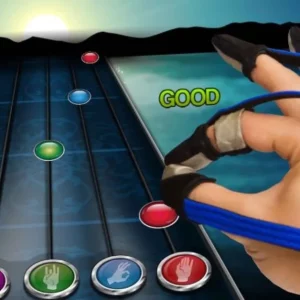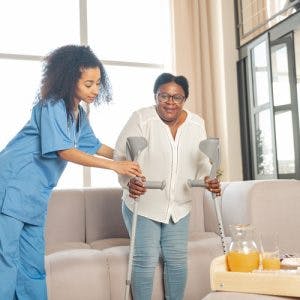After a stroke, many individuals may struggle to perform the activities of daily living due to limited mobility and other physical or cognitive deficits. Fortunately, adaptive equipment for stroke patients can help make the activities of daily living easier to perform.
By using adaptive equipment, many stroke survivors are able to independently walk, bathe, dress, eat, and communicate, making it easier to engage in their daily lives.
This article will discuss the benefits and drawbacks of using adaptive equipment during stroke rehabilitation and some of the best tools to choose from.
Top Adaptive Equipment for Stroke Patients
There are various assistive devices that can help survivors manage the physical and cognitive effects of a stroke that interfere with daily activities. Many devices are commercially available, or they can be homemade by health care professionals or family members.
An occupational therapist is an excellent resource when considering adaptive equipment for stroke patients. They are well-versed in the various types of adaptive equipment and are able to provide stroke survivors with adaptive equipment recommendations and training during their therapy sessions.
To help you gain a better understanding of which devices may be beneficial for you, we’ve compiled a list of the most commonly used types of adaptive equipment for stroke patients.
1. Mobility & Walking
Adaptive equipment such as scooters, wheelchairs, canes, walkers, and ankle-foot orthotics (AFOs) can provide support to individuals with limited mobility and other physical impairments. For example, if you have enough strength and mobility in your legs to walk, but struggle with balance, you may benefit from using a walker or a cane. This could help you to move around safely, while still allowing you to maintain and even improve your leg strength.
If your leg strength has been significantly affected by your stroke, but you have strength in your arms, a manual wheelchair may be a great option. Stroke survivors with hemiplegia, or paralysis on one side of the body, may benefit from more specialized types of mobility devices such as a hemiwalker or platform walker. A physical or occupational therapist can provide guidance on which assistive device is best for you.
Find Mobility Equipment on Amazon >>>
2. Bathroom & Bathing
Bathing and toileting are two essential activities of daily living. Adaptive equipment such as shower chairs, tub benches and anti-slip rubber mats can provide support and stability when performing these activities, lowering the risk of slips or falls.
Therapists may also recommend adding handheld showerheads to make it easier to wash your body. Bath mitts and long-handled sponges can also be used to help you clean harder to reach areas like your back and feet. These assistive devices are simple and cost-effective, making them popular among stroke survivors.
Bathroom accessibility may also be a concern for many stroke survivors and loved ones. The toileting process, which involves safely entering the bathroom, getting on and off the toilet seat, and managing clothing, can be challenging. Adaptive equipment such as toilet frames with handles, raised toilet seats, and grab bars can help make this process both safer and smoother after a stroke.
Find Bathroom Safety Equipment on Amazon >>>
3. Dressing & Grooming
Re-learning daily tasks such as how to get dressed and ready for the day is an essential part of stroke recovery, but it can take time. Fortunately, adaptive equipment can help. For example, to help you put on your pants, shoes, or socks with more ease you can use pant hooks, long-handled shoehorns, and sock-aids. These are great tools for stroke patients because they limit the need to bend over when dressing.
Furthermore, magnetic buttons for shirts or pants can provide a simpler and more efficient way of dressing, along with reachers to help you firmly grasp and pick up clothing off the floor. It can also help to wear velcro shoes, elastic lace shoes, or shoes with zippers to help you put on your shoes easier and faster.
Using an electric toothbrush or electric razor may help stroke survivors with limited hand mobility and coordination complete grooming tasks more easily. Your occupational therapist can provide you with further recommendations specific to your needs.
Find Dressing & Grooming Equipment on Amazon >>>
4. Preparing Meals, Eating, & Feeding
Stroke survivors may experience difficulty with fine motor coordination or gripping small objects, which can interfere with eating and preparing meals. To help you eat, you can try using adaptive utensils. One of the most common ways to create your own easy to grip adaptive utensils is by using built-up handles. These foam tubes can be placed over the handle of your silverware, making it easier to grip. Built-up handles can also be used for other utensils, such as pencils, razors, or toothbrushes.
Those with more limited mobility in the hand may prefer forks with bendable foam handles, which can molded around the wrist to maintain a good grip. You can also use angled spoons and forks to eat without the need to bend your wrist. Adaptive cups, plates and bowls are also available to make eating easier. Other adaptive equipment such as adaptive cutting boards and rocker knives can help stroke patients make cooking and preparing meals more doable.
Find Meal Prepping Devices on Amazon >>>
5. Memory
After a stroke, some individuals may lose track of time, be unable to retrace a route they took, or even forget key details from a conversation. To help manage memory problems after a stroke it can help to use assistive tools such as labels and checklists. For example, you can place labels on bedroom drawers, kitchen cupboards, and bathroom cabinets to help you easily identify the items you need.
This can also help you recall where the items are for the next time you need to use them. Checklists are another tool that can help you keep track of time and your daily activities. While hand-written notes are often recommended, there are plenty of apps for stroke patients that can help you create a checklist on your smartphone or tablet.
6. Communication & Technology
Using technology after a stroke can be challenging because it often requires strong fine motor skills. While rehabilitation can help you to improve these skills, many survivors find that using adaptive equipment in the meantime can help with accessing certain technological devices.
For example, you may consider using an adaptive keyboard to help you operate a computer more efficiently. While there are various types, many adaptive keyboards are designed to help individuals who have difficulty controlling movement in their hands and fingers.
Being able to access and use technology is also essential for many forms of communication. Instead of texting or emailing someone, you can use voice typing or a recording device like the one on your smartphone or tablet. Recording devices can also help you recall dates, doctor appointments, and other important information you may need.
Survivors who have trouble with speaking, such as those with post-stroke aphasia, may find that communication aids can help them express themselves more easily. This can include using picture boards or specialized devices to communicate. Speech language therapists are experts in this area, and can help you find a communication strategy that works best for you.
Find Adaptive Keyboards on Amazon >>>
7. Leisure Activities
While it can be challenging, and at times even discouraging, to return to the activities you once enjoyed before a stroke, there are various assistive devices that can help you participate in your favorite leisure activities again.
For example, if you enjoy fishing you can use a fishing rod holder to help you hold the rod more firmly. The fishing rod usually straps to the body, but it can also be attached to a wheelchair. There are also automatic card shufflers available for your next game night. With the proper adaptive equipment, you can engage in a variety of fun activities for stroke patients.
How to Effectively Use Adaptive Equipment During Stroke Recovery
Adaptive equipment can help you regain a sense of independence after a stroke. While using adaptive equipment is helpful, it’s important to understand that it is a compensatory tactic that helps make up for lost motor and/or cognitive function. Relying solely on compensatory strategies during rehabilitation can cause you to plateau or even lose more function.
To lower the risk of plateau or loss of function, occupational therapists recommend incorporating restorative techniques into your rehabilitation regimen. Restorative techniques focus on helping you regain lost function and rather than just adapting to your current skill level.
For example, a walker would be considered a compensation tactic for walking, while physical therapy exercises for the legs and core would be restorative techniques. This is because high repetition of rehab exercise helps stimulate neuroplasticity, the brain’s natural ability to heal itself.
To keep neuroplasticity activated, it’s important to establish a proper home rehabilitation program and use adaptive equipment for stroke recovery as needed. Occupational therapists are great resources in finding the most effective adaptive equipment for stroke patients while also using restorative interventions tailored to your specific needs.
Additionally, to help you stay motivated during your rehabilitation process and practice exercises daily, you can use neurorehabilitation devices, such as FitMi. These devices help encourage you to practice therapeutic exercises regularly at home in between your therapy sessions. The more you practice, the higher the chances of improving function, and the greater the possibility of making a full stroke recovery.
Find Devices for Stroke Recovery on Flint Rehab >>>
Understanding Adaptive Equipment for Stroke Patients
Navigating life after a stroke can bring many obstacles and challenges that can interfere with the activities of daily living and even rehabilitation. Fortunately, adaptive equipment for stroke patients can help make this transition smoother.
Assistive devices can help you complete daily tasks such as bathing, eating, grooming, and even walking. A therapist can provide more guidance to help you choose the right adaptive equipment for your needs.
We hope this article helped you understand the benefits of using adaptive equipment for stroke patients.










